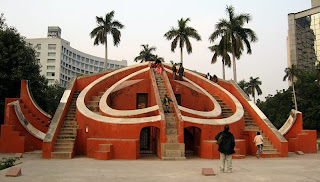The Misra Yantra is located in the northwestern corner of the site. It is a relatively small instrument, and may have been built by Jai Singh's son, Madho Singh (reg. 1751-65) sometime between 1759 and 1799, as the instrument is not mentioned in Jai Singh's accounts. The entire instrument measures about 25 meters across (east-west) and 12 meters north-south.
 |
| Misra Yantra in Jantar Mantar, Delhi Observatory |
The Misra Yantra is organized symmetrically about a wall whose upper edge is inclined to the horizontal plane at the same angle as the hypotenuse of the Samrat Yantra. This wall is formed of two walls flanking a staircase used to access the top; while smaller, it is similar to the Samrat Yantra gnomon. The wall is 8 meters high, and and its base stretches for ca. 11 meters. A pair of semicircular scales are located on each side of the gnomon, with their centers located on the hypotenuse of the central wall. These four scales are marble strips, .5 meters wide and supported on individual curved walls. A staircase, about 1 meter long, runs between each pair of scales. The semicircles on the eastern side are inclined at angles corresponding to the meridians of Greenwich and Zurich. Like the hypotenuse, their inclination is upwards from south towards the north. The semicircles on the western side are mirror images of the eastern pair, and correspond to meridians of places in East Asia. This may be coincidental, as the symmetry of the instruments appears to have been the overriding determinant of their inclination. The calibrations on the marble scales can be read by climbing either the staircases located along the outer edge of the curved walls or the staircases in between them. Two doorways, about a meter wide and spanned by segmental arches, puncture the outer curved walls on either side of the gnomon to enable access to the inner staircases. The instrument has three additional quadrants, two on the west and one on the eastern side of the gnomon.
No comments:
Post a Comment